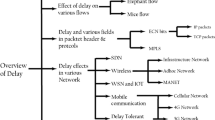Abstract
The provisioning of quality of service in networks requires a proper scheduling algorithm. The nature of network traffic, especially real-time multimedia applications, is bursty, thus in addition to the service rate (which is commonly used to isolate sessions’ service), other parameters should be involved. In this paper we analyze our proposed scheduling algorithm [Burst Service SCFQ, BSCFQ (Daneshvar et al. in Int J Wirel Mobile Netw 5, 2013)] which attempts to provide a balance between bursty and non-bursty (smooth) traffics. BSCFQ is an improvement of Self-Clock Fair Queueing (SCFQ), a well-known packet scheduling algorithm, in order to be able to compensate for an adjustable amount of missed service to each session. BSCFQ is evaluated by calculating the fairness index, burst service which is defined by the authors and delay bound. Our improvement in the SCFQ does not necessitate any additional computation as regards the implement algorithm.





Similar content being viewed by others
References
Daneshvar, M. F., Saidi, H., & Mahdavi, M. (April 2013). Improving SCFQ to support bursty traffic. International Journal of Wireless & Mobile Networks (IJWMN), 5(2), 21–31.
Stiliadis, D., & Varma, A. (1998). Rate-proportional servers: A design methodology for fair queueing algorithms. IEEE/ACM Transactions on Networking, 6(2), 175–185.
Annadurai, C. (February 2011). Review of packet scheduling algorithms in mobile AdHoc networks. International Journal of Computer Applications, 15(1), 7–10.
Zhang, H., & Keshav, S. (1991). Comparison of rate-based service disciplines. In Proceedings of the ACM conference on communications architecture & protocols, pp. 113–121.
Goyal, P., & Vin, H. (1997). Generalized guaranteed rate scheduling algorithms: A framework. IEEE/ACM Transaction on Networking, 5(4), 561–571.
Stiliadis, D., & Varma, A. (1998). Latency-Rate servers: A general model for analysis of traffic scheduling algorithms. IEEE/ACM Transactions on Networking (ToN), 6(5), 611–624.
Dwekat, Z., & Rouskas, G. N. (2011). A practical fair queuing scheduler: Simplification through quantization. Computer Networks, 55, 2392–2406.
Kalle, R., Devi, U. C., & Kalyanaraman, S. (2011). Multi-tiered, burstiness-aware bandwidth estimation and scheduling for VBR video flows. In Proceedings of IEEE international workshop on quality of service (IWQoS), pp. 1–9.
Sbrina, F. (2010). A novel resource scheduling algorithm for QoS-aware services on the Internet. Journal of Computer and Electrical Engineering, 36(4), 718–734.
Golestani, S. (1994). A self-clocked fair queueing scheme for broadband applications. In Proceedings of INFOCOM, pp. 636–646.
Parekh, A., & Gallager, R. (1993). A generalized processor sharing approach to flow control in integrated services networks: The single-node case. IEEE/ACM Transactions on Networking (TON), 1(3), 344–357.
Miaji, Y., & Hassan, S. (2009). A survey on the chronological evolution of timestamp schedulers in packet switching networks. In Proceedings of IC-BNMT.
Stiliadis, D., & Varma, A. (1998). Efficient fair queueing algorithms for packet-switched networks. IEEE/ACM Transactions on Networking (TON), 6(2), 175–185.
Katevenis, M., Stefanos, S., & Courcoubetis, C. (1991). Weighted round-robin cell multiplexing in a general-purpose ATM switch chip. IEEE Journal on Selected Areas in Communications, 9(8), 1265–1279.
Siriwong, K., Lipsky, L., & Ammar, R. (2007). Study of bursty internet traffic. In Proceedings of IEEE International Symposium on Network Computing and Applications, pp. 53–60.
Aldeer, M. M. N. (2010). Performance comparison of packet-level multiplexing algorithms with bursty traffic. Journal of Engineering Science and Technology, 3(1), 46–52.
Lan, S. S., & Xie, G. G. (1995). Burst scheduling: Architecture and algorithm for switching packet video. IEEE/ACM Transaction on Networking, 3(6), 683–690.
Golestani, S. J. (1991). Congestion-free communication in high-speed packet network. IEEE Transactions on Communications, 39(12), 1802–1812.
Hamadoui, M., & Ramanathan, P. (1995). A dynamic priority assignment technique for streams with (m, k)-firm deadlines. IEEE Transactions on Computers Communication, 44(12), 1443–1451.
Callegati, F., Campi, A., & Cerroni, W. (2010). A practical approach to scheduler implementation for optical burst/packet switching. In Proceedings of ONDM, pp. 1–6.
Rosberg, Z., Ji, Li, Fan, Li, & Zukerman, M. (2011). Flow scheduling in optical flow switched (OFS) networks under transient conditions. Journal of Light way Technology, 29(21), 3250–3264.
Zhu, H., & Cao, G. (2004). On improving service differentiation under bursty data traffic in wireless networks. In Proceedings of INFOCOM, pp. 871–881.
Lee, D Sh, Chen, Ch M, & Tang, Ch-Y. (2007). Weighted Fair Queueing and compensation techniques for wireless packet switched networks. IEEE Transactions on Vehicular Technology, 56(1), 887–891.
Choi, Y. J., & Kim, H. M. (2007). A new scheduling scheme: For high-speed packet networks earliest-virtual-deadline-first. Computer Communications, 30, 2291–2300.
Kwon, T.G., Lee, S.H., & Rho, J. K. (1998). Scheduling algorithm for real-time burst traffic using dynamic weighted round Robin. IEEE International Symposium on Circuits and Systems, 16, 506–509.
Daneshvar, M. F., Saidi, H., & Mahdavi, M. (2012). A Scheduling algorithm for controlling of service rate and burst. In Proceedings of ADCOM, India.
Mart’ınez, R., Alfaro, F. J., S’anchez, J. L., & Claver, J. M. (2009). Hardware implementation study of the SCFQ-CA and DRR-CA scheduling algorithms. Lecture Notes in Computer Science, 5704, 1089–1100.
Halabian, H., & Saidi, H. (2008). A low complexity Fair Queueing algorithm for broadband networks. In Proceedings of ICTTA.
Choi, B. H., & Park, H. S. (2000). Rate proportional SCFQ algorithm for high-speed packet-switched networks. ETRI Journal, 22(3), 1–9.
Koutsakis, P. (2005). Multiplexing voice and SMS traffic with bursty video over next generation wireless networks with capture. In Proceedings of the international conference on parallel processing workshops (ICPPW’05).
Kvols, K., & Blaabjerg, S. (1992). Bounds and approximations for the periodic ON/OFF queue with applications to ATM traffic control. In Proceedings of INFOCOM, vol. 2, pp. 487–492.
Author information
Authors and Affiliations
Corresponding author
Rights and permissions
About this article
Cite this article
Daneshvar Farzanegan, M., Saidi, H. & Mahdavi, M. Analysis of BSCFQ: A Modified Version of SCFQ to Support Bursty Traffic. Wireless Pers Commun 75, 2449–2466 (2014). https://doi.org/10.1007/s11277-013-1476-2
Published:
Issue Date:
DOI: https://doi.org/10.1007/s11277-013-1476-2




